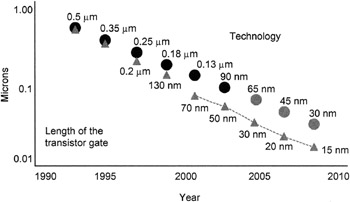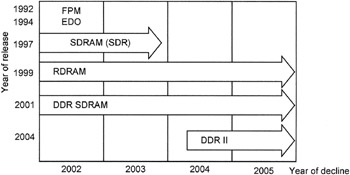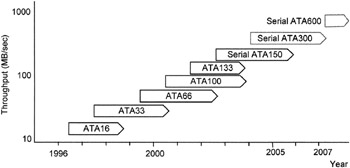Evolution of Technologies and Components
|
| < Day Day Up > |
|
Computing technologies are evolving, and new hardware and software appear constantly. Therefore, the lifetime of computer hardware components shortens constantly. As new components with higher performance and better quality appear on the market, it becomes economically unjustifiable to work with obsolete prototypes. This happens despite advances in manufacturing technology, reliability improvements, and the mean time between failures (MTBF).
| Process name | P854 | P856 | P858 | Px60 | P1262 | P1264 |
|---|---|---|---|---|---|---|
| Implementation (year) | 1995 | 1997 | 1999 | 2001 | 2003 | 2005 [*] |
| Lithography (nanometers) | 350 | 250 | 180 | 130 | 90 | 65 |
| Gate length (nanometers) | 350 | 200 | 130 | <70 | <50 | <35 |
|
[*]anticipated | ||||||
Currently, the average maximum lifetime of processors, video adapters, and hard disks is five years. However, most people try to replace these components while they still are usable and operating satisfactorily. Typical computer users replace components after two or three years. However, the high reliability of computer components makes it possible to use them for more than ten years.

Figure 2.2: Forecast for the evolution of Intel's semiconductor technology
These estimates also apply to central processing units (CPUs). Despite their complexity, these components are capable of working ten years or more. Still, significant changes, often referred to as new architecture, are introduced into the core of CPUs every three or four years. Standards for processor slots, via which CPUs are installed on motherboards, change even more frequently. Newer and more advanced processor models manufactured within the same line of products are usually released every few months. These newer models often are incompatible with the platforms designed for their predecessors, even if the processor-slot type is preserved. For example, Intel Pentium processors with MMX technology were designed, like earlier models of Intel Pentium, for the Socket 7 slot. However, in contrast to their predecessors, PMMX processors required motherboards that provided two levels of a processor's core voltage. This means that newer processors based on the P5 architecture required platform replacement. A similar situation took place with the arrival of processors created using 130-nanometer technology. Like their predecessors — Intel Pentium III processors based on 180-nanometer technology — they had P6 architecture. However, despite retaining the same type of socket — Socket 370, generally manufactured in those days — the newer processors needed a change of core voltage as well as the release of new chipsets. Once again, this meant that new motherboards were required.
Similar situations even took place for high-tech products. The evolution of CPU architecture and the form factors for Intel Pentium 4 processors also initiated corrections and changes to the PC platforms that supported these processors. Changes in power supply became traditional; they took place not only with changes to core architecture, but also with the migration from 180-nanometer to 130-nanometer technology. Form factors of the released models also changed. The Socket 423 standard, introduced for the earliest models of these processors, lasted only one year. After that, it was replaced by the incompatible Socket 478, which, as usual, required newly designed and manufactured motherboards and power supply units (i.e., a complete replacement of the PC platform).
| Processor | Slots | Year of release |
|---|---|---|
| 8086 | - | 1978 |
| 286 | - | 1982 |
| 386 | - | 1985 |
| 486DX | Socket 1/Socket 2/Socket 3/Socket 6 | 1989 |
| Pentium/Pentium with MMX technology | Socket 4/Socket 5/Socket 7 | 1993 |
| Pentium II/Pentium III | Slot 1/Socket 370 | 1997 |
| Pentium 4 (Willamette/Northwood/Prescott) | Socket 473/Socket 478/Socket T (Socket 775) | 2000 |
Advances in computing technologies have changed other components, such as video adapters. Within a short time interval, the video subsystem of the PC has cycled through the following interfaces: Industry Standard Architecture (ISA), Video Local Bus (VLB), Peripheral Component Interconnect (PCI), and Accelerated Graphics Port (AGP). These interfaces have several types of specifications, which set standards for a range of specialized video adapters. For example, the AGP video adapters that dominate today's market have evolved over several generations: AGP 1X, AGP 2X, AGP 4X, and AGP 8X. They differ not only in performance, but also in the requirements of their electric, logical, and design interfaces, which makes video-adapter compatibility impossible. A new, advanced, and promising interface, PCI Express (at development time, it was known as 3GIO), also requires new designs for video adapters and motherboards.
As a result of this interface evolution, platforms change every two or three years, keeping pace with the release of new lines of video adapters that support more advanced interfaces.
| Video adapter | Throughput (MB/sec) | Year of release |
|---|---|---|
| ISA | 8 | 1984 |
| VLB | 100–133 | 1992 |
| PCI | 133 | 1993 |
| AGP | 266 | 1997 |
| AGP 2X | 533 | 1998 |
| AGP 4X | 1,066 | 1999 |
| AGP 8X | 2,100 | 2002 |
| PCI Express | 2,100+ | 2004 [*] |
|
[*]anticipated | ||
The situation with RAM is no less dramatic. RAM also is subject to constant changes of types, interfaces, and form factors. During the relatively short time that has elapsed since the arrival of the first PCs, several mutually incompatible types of RAM have appeared.
| RAM type | Year of release |
|---|---|
| FPM DRAM | 1992 |
| EDO DRAM | 1994 |
| SDRAM (SDR SDRAM) | 1997 |
| DRDRAM | 1999 |
| DDR SDRAM | 2001 |
| DDR II SDRAM | 2004 [*] |
|
[*]anticipated | |
Each RAM type had several versions with different frequency and timing parameters. For example, Single Data Rate (SDR) Synchronous Dynamic Random Access Memory (SDRAM), usually referred to as just SDRAM, has modules corresponding to PC66, PC100, and PC133 specifications. (The digits in the specification names designate their maximum operating clock frequencies: 66 MHz, 100 MHz, and 133 MHz.) Double Data Rate (DDR) SDRAM contains modules designed to operate at frequencies of 100 MHz, 133 MHz, 166 MHz, and 200 MHz. DDR SDRAM ensures a data rate twice that of SDR SDRAM, even at the same frequencies. DDR SDRAM modules are intended to operate at 2.5 V, SDR SDRAM at 3.3 V, and Extended Data Output (EDO) SDRAM at 3.3 V or 5 V. Compatibility is complicated by different form factors for modules released at different stages of microprocessor evolution. Examples of common form factors of the RAM module include Single In-line Pin Package (SIPP), Single In-line Memory Module (SIMM), Dual In-line Memory Module (DIMM), and the RIMM memory module. (RIMM often is referred to incorrectly, with "R" standing for "Rambus." However, the term RIMM is not an acronym; it has been trademarked.) Each form factor has several variants with different sizes and different numbers of pins.

Figure 2.3: Forecast for the evolution of RAM
It should not be necessary to prove that these differences result in the incompatibility of memory modules.
Other components, such as hard disks, also evolve at a rapid rate. During the last few years, hard-disk capacity usually doubled every 9 to 12 months. The MTBF declared by manufacturers often exceeds 500,000 hours.
In contrast to processors, video adapters, and RAM, new hard-disk models retain compatibility with earlier models for a long time. For example, ATA100 (100 MB/sec) disks can be connected to ATA66 (66 MB/sec) and even to ATA33 (33 MB/sec) controllers. However, with such connections, you cannot get the maximum speed potential. Furthermore, it is impossible to achieve the full compatibility of Advanced Technology Attachment (ATA) devices with controllers implementing Serial ATA150 (150 MB/sec) and Serial ATA300 (300 MB/sec) interfaces. The same relates to the compatibility between Serial ATA150 devices and parallel interface ATA100/66/33 controllers.
| Bus | Throughput (MB/sec) | Year of release |
|---|---|---|
| ATA16 | 16.7 | 1996 |
| ATA33 | 33.3 | 1997 |
| ATA66 | 66.7 | 1999 |
| ATA100 | 100 | 2000 |
| ATA133 | 133 | 2001 |
| Serial ATA150 | 150 | 2002 |
| Serial ATA300 | 300 | 2004 [*] |
| Serial ATA600 | 600 | 2007[*] |
|
[*]anticipated | ||

Figure 2.4: Forecast for the evolution of the ATA interface
The data provided in this chapter prove that the rapid progress of semiconductor technologies and of the architecture of computer components doesn't allow standards, interfaces, and form factors to be retained for long periods of time.
| Components | Period (years) |
|---|---|
| Processors | 3–4 |
| Video adapters | 2–3 |
| RAM | 2–3 |
| Hard disks | 1–2 |
Under such conditions, after several years of operation, it becomes impossible to upgrade a computer system by simply replacing obsolete components.
|
| < Day Day Up > |
|
EAN: 2147483647
Pages: 111